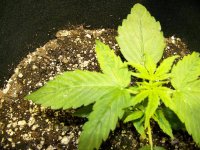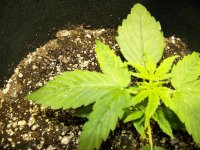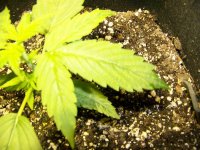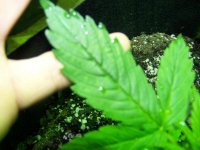New grower, or new to being able to solve this issue. I am growing in Happy Frog soil, feeding General Hydroponic micro and veg, and just started adding a weak solution of CalMag
-
ICMag with help from Landrace Warden and The Vault is running a NEW contest in November! You can check it here. Prizes are seeds & forum premium access. Come join in!
You are using an out of date browser. It may not display this or other websites correctly.
You should upgrade or use an alternative browser.
You should upgrade or use an alternative browser.
Tahoe OG, light green spotting
- Thread starter lacerta
- Start date
Furthermore, avoid water droplets on leaves during watering. It magnifies the light <--- read heat.
Not really.
https://www.abc.net.au/science/articles/2016/06/07/4475079.htm
Can water burn plant leaves?
There may be a whole range of reasons why it's not good to water plants in the middle of the day, but is burning the plant's leaves one of them? Dr Karl investigates the physics of plants and water.
One factoid that I have been told many times is to never water the garden plants under the powerful glare of the midday sun.
The accepted wisdom has been that a water droplet sitting on a leaf would act like a tiny magnifying lens, and by focusing that sunlight would produce scorch marks and burns on the innocent leaf.
And if you go looking on the interwebs, about 80 per cent of relevant sites claim that water droplets plus the midday sun will burn the leaf.
Finally, after what must be centuries of this widespread belief, some scientists have checked out the theory and done the experiments — and here are the results.
Burning a leaf with a water droplet does not happen on a smooth leaf, and is just barely possible on a hairy leaf.
Smooth leaves
Dr Adam Egri and colleagues from Hungary and Germany carried out both computer modelling, and tests, on real leaves. In their experiments, they used both little glass balls and water droplets.
In their first study, they covered the surface of a smooth leaf with glass balls ranging in size from 2 to 10 millimetres. They exposed them to the sun for periods between one and nine hours. And sure enough, there were scorch marks.
So it would seem as though there was some truth to the claim that water droplets could burn leaves. Mind you, glass balls keep their shape, unlike water droplets that spread out and flatten. The other difference is that glass bends light about 15 per cent better than water does.
So the second study had water droplets on smooth leaves. But, no matter how they altered various factors, they could not get the sunlight shining through the water droplets to burn the smooth leaves.
When the sun was shining from directly above, the light would be brought to a focus underneath the water droplet, and inside the body of the leaf. But there was a big blob of water sitting on top of the leaf, soaking up the heat. Any heat that got into the leaf was immediately transferred to the water. Then, as the water got warmer, it evaporated itself out of existence. And once there was no water droplet, there was no focusing of the heat. So there were no burn marks on the leaf — for the midday sun.
What about sunlight in the morning and afternoon, when the slanting light was beaming through the water droplet, and landing on the bare leaf just outside water droplet? Could that cause a burn? The answer turned out to be 'no'.
Well, when the Sun is just above the horizon, the sunlight is travelling through about 22 times more air than when the Sun is directly above you, at the vertex, around midday. So there's not enough heat to burn.
What about the shape of the water droplet? After all, different leaves have different degrees of 'hydrophilia' or 'water-loving' tendency. So the scientists tested leaves from various trees — maple (very water-loving), plane (less water-loving) and rowan (water-hating, or 'hydrophobic').
At the water-loving end (maple), the water droplets were very flattened, while at the water-hating end (rowan), the droplets were fairly spherical.
As you would expect, the more spherical water droplets on the water-hating leaves did concentrate the heat better, but not enough to scorch the leaf. So sunlight shining through water droplets doesn't burn smooth leaves.
Hairy leaves
But what about the hairy plants? The leaves have hairs that are 'hydrophobic' or 'water-hating'. Under the right circumstances, these hairs could catch a water droplet and keep it suspended at the right distance above the leaf, to allow the focus point of the sunlight to land on the surface of the leaf. Because the water was not in contact with the leaf, there was no cooling effect. And the hairs, being water-hating, would repel the water, and so keep it spherical — the best shape to focus the sunlight.
But the hairs hate water, and the merest breath of wind would shake the droplets off. The smaller droplets were better at focusing the heat — but being smaller, they would also evaporate very quickly.
Even so, the scientists did sometimes see scorch marks produced by water droplets on hairy leaves.
How did this 'don't-water-plants-at-midday' story arise? Who knows?
But you'd think that after half-a-billion years of bio-evolution, plants (which have adapted to every conceivable ecological niche) would have learnt to deal with a little rain ...
The pH looks a little too low.New grower, or new to being able to solve this issue. I am growing in Happy Frog soil, feeding General Hydroponic micro and veg, and just started adding a weak solution of CalMag
0.4 EC of bloom food (Low Nitrogen, higher P and K)
0.1 EC of Epsom Salt (Mg + S) - Mg is what the leaves need
Tapwater
Total EC: 0.5 + tapwater's EC
pH : 7.0-8.0
For the growing part, you need a higher pH because it increases the uptake of P and K.
And when they're bigger, repot into a larger container and repeat the above nutrients. Especially with a prefertilized soil like Fox Farm you wouldn't need a lot more.
Also, when you use soil like this, it never hurts to add a tablespoon of magnesium lime before repotting, and then let it soak in water for a few days to a week.
Also, if you use perlite or grow rock, you should put them in a tub with water too, so they won't have dust on them and for them to take up water too.
NEED 4 SEED
Well-known member
I like this study cause it empties the old myth. But what about using water plus fertilizer in it? I read in an old book from the 60s that you shouldn't fertilize in the morning or at high noon. Could the salts that remain on the leaves do any damage and what about hard water?
ph too high
ph too high
Fox farms Happy frog has a pH of 7. General Hydroponic micro and veg alone, will not drop the pH enough to allow Iron to become available.
When you mix your nutrients be sure and use Bloom with every mix because it will help lower the pH to a lower range. The goal is to have a pH where all nutrient are available. If after adding all 3 series Gen hydor nutes you may still may need a little pH down.
ph too high
Fox farms Happy frog has a pH of 7. General Hydroponic micro and veg alone, will not drop the pH enough to allow Iron to become available.
When you mix your nutrients be sure and use Bloom with every mix because it will help lower the pH to a lower range. The goal is to have a pH where all nutrient are available. If after adding all 3 series Gen hydor nutes you may still may need a little pH down.
If you don't want suggestions then don't put your grow in the Infirmary.
Most of the problems I see in the infirmary are caused from people trying to pull a rabbit out of a hat by doing magic. When you miss match products you get mixed results. All products lines have an effect when matching fertilizer and Substrate. If you are not matched with the right match you will have problems during the grow. All matched products will always give the best results when using fertilizer and soil substrates together.
Last edited:







